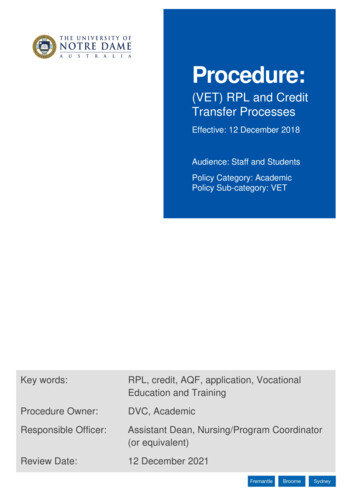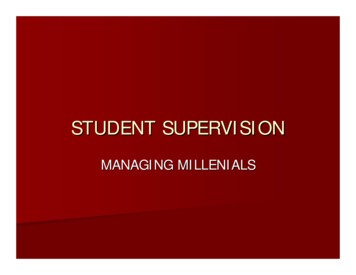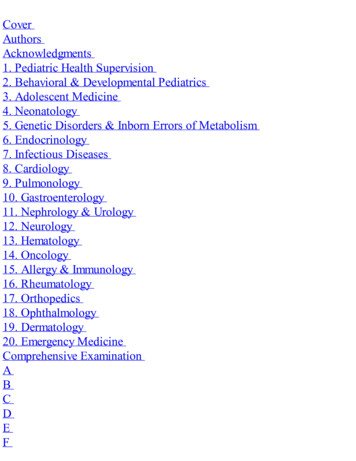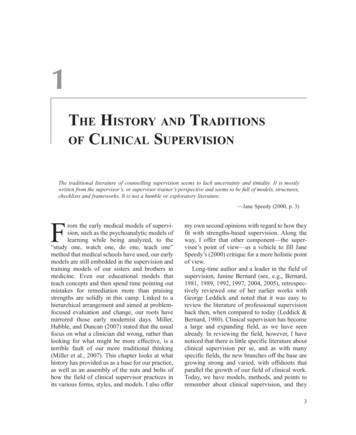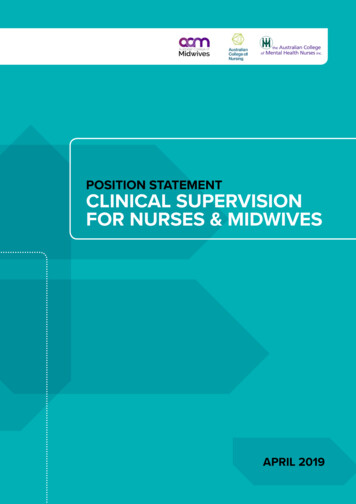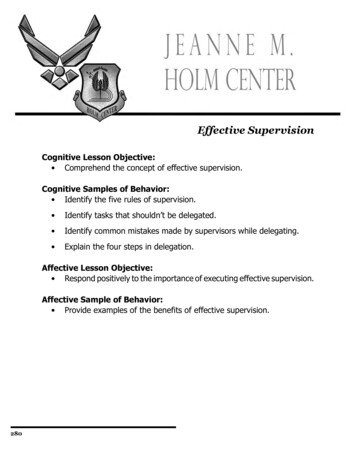
Transcription
Effective SupervisionCognitive Lesson Objective: Comprehend the concept of effective supervision.Cognitive Samples of Behavior: Identify the five rules of supervision. Identify tasks that shouldn’t be delegated. Identify common mistakes made by supervisors while delegating. Explain the four steps in delegation.Affective Lesson Objective: Respond positively to the importance of executing effective supervision.Affective Sample of Behavior: Provide examples of the benefits of effective supervision.280
A supervisor’s words and actions have great impact on the behavior of subordinatesand the responsiveness of the organization to leadership efforts. Consider the case ofa second lieutenant given a task by his commander to improve the performance of hissubordinates. A few months later, the subordinates had already forgotten everything thelieutenant had discussed with them during their first meeting. Except for his openingstatement, they would never forget that: “I have been sent in to straighten things outaround here.” At that moment, resistance to his leadership was born. If asked, many ofthe subordinates could probably have suggested changes to improve the organization.However, the lieutenant didn’t ask. He told them, and they resisted every change hesought to introduce.Your success as a leader will depend on your skill as a supervisor. Your supervisory skills,in turn, depend on how well you learn and apply key principles of supervision.Remember the difference between a boss and a leader: a boss says, “Go!”-a leader says, “Let’s go!”E.M. KellyAs an officer, you’ll be charged not only with managing your section, but also supervising yourpeople. We should first distinguish between these two functions. The Air Force definitionof management, which you encountered in Management Functions and Principles, isbroad-- “the process of organizing and using resources to accomplish predeterminedobjectives.” The term “supervision” is a specialized function within this overall objective.Insofar as you consider your personnel as material cogs in the functioning of a unit, youare a manager, but as you deal with them as differentiated human beings, you are asupervisor. As one writer succinctly put it, “We manage things, we supervise people.”This distinction is important because material resources and human resources differfundamentally. A gun, a tank, or a typewriter is designed to reach a certain level ofperformance. With proper maintenance and use, machines will not fall short of this levelnor will they ever exceed it. Human resources, on the other hand, have no pre-engineeredperformance level, in speaking of the great variability of human achievement, we mustuse the vague term “potential.” Unlike a machine or a robot, human workers can excel.Under the proper circumstances, they can achieve virtually unlimited development.Thus, “human maintenance”--i.e., supervision--is a very different task from mechanical ormanagerial maintenance. In a time of budgetary constraints, the Air Force recognizes theimportance of effective supervision in tapping our great human potential. To this end, ourmanagers must also become effective supervisors.Effective Supervision 281
DEFINITIONSupervision means literally, the “overseeing” (not the “overlooking”) of people withina work unit, with the purpose of achieving maximum productivity through them.For a supervisor to “oversee” people implies not only a power relationship (i.e.,the OIC is “over” people; the supervisor as boss), but also a knowledge relationship. Ifthe hierarchical organization is a pyramid, the person at the top sees more by virtue ofthat vantage point. The supervisor is able to take in the whole of the section’s integratedmission, as well as observe each person’s contribution to that mission. However, thesupervisor’s task doesn’t end here. The supervisor communicates what he/she sees tohis/her subordinates. Unfortunately, many otherwise skilled managers neglect the secondof these tasks, assuming that their people know all they need to know for the performanceof their jobs. However, this isn’t the case. A bad supervisory relationship is usually markedby a breakdown of communication between the supervisor and subordinates, resulting infrustration, confusion, and lower productivity.FIVE RULES OF SUPERVISIONThe following five rules are offered as general guidelines for improving your performanceas a supervisor.1. Get involved. Supervision isn’t an armchair occupation, nor does “getting involved”mean running your section “by decree” from a closed office. It means getting out andunderstanding the day-to-day operation firsthand. It means knowing your people asindividuals and being known by them. Real involvement on the part of the supervisorreaps two advantages. First, it will provide you with knowledge about your section that isunobtainable any other way. Secondly, frequent interaction with your people promoteswhat managerial experts call a “therapeutic climate”--the supervisor demonstratesconcern for the workers’ daily performance, rather than taking it for granted. Visibleand personal involvement by the supervisor builds morale and a sense of cohesionwithin the entire section. This forms a substantial base for a productive supervisorsubordinate relationship.2. Open channels of communication. Effective communication probably won’t occurunless you, as supervisor, take active steps to open channels between yourself andyour subordinates. To be effective, communication should travel in both directions-from the bottom up, as well as from the top down. Most important, you must createsituations in which frank communication is possible and likely to occur. Here are someeffective practices:282--Schedule meetings for the entire work center. The frequency may vary, dependingon the type of organization, and they don’t need to follow a regular schedule.Whatever the case, these meetings should be inclusive.--Invite suggestions, and use them whenever possible.
--Be available for discussions. Have an open door policy.Open communication within an organization tends to bind the group more closelyinto a cohesive unit. Instead of working in isolation, people feel they’re part of agroup with common goals. Some situations, of course, may demand that you actdecisively without prior consultation. In any case, you should at least ensure thatyour people understand the decision making process, rather than perceiving it assomething inexplicably imposed from above. Share your view from the top--it’s one ofyour primary responsibilities as a supervisor.3. Give your people a chance to develop. Human beings, unlike machines, are inherentlydynamic. They work best in situations where they can develop themselves, rather thansimply repeat a static routine. Allowing for and promoting worker development is akey to effective human relations. Be sensitive to individual differences in your people.Tailor their duties and their training to match their respective capacities. People, doingoutstanding work or who demonstrate superior capacity, should be challenged withtasks that are more responsible. As a supervisor, you’ll be responsible for providinga graduated challenge to the people in your section, as well as keeping track oftheir long-term training and development. To do this requires great sensitivity andflexibility on the part of the supervisor. Rigid formalism and mindless adherence towork routines are the great barriers to a dynamic work environment; while the resultsmay be adequate, such practices will result in stagnation and discontent.For example, know the promotion and testing requirements of the enlisted people inyour section. An enlisted member may work in the Mobility section, but, as a part ofupgrade training, may have to take Career Development Course (CDC) tests overseveral areas of the logistics career field, not just mobility. It is important to rotateyour people through many jobs within the section to give them experience in variousaspects of their career.4. Establish standards and stick to them. A major part of your job as supervisor willbe to evaluate the people in your section. Since all evaluations must be based onsome standard of judgment, the supervisor should communicate job performancestandards to the workers at the outset. At the earliest opportunity, meet with eachperson (individually, if possible) and spell out exactly what you expect. Be forthright-workers are entitled to know the standards upon which they’ll be judged. Once you’veestablished and explained a framework for evaluation, stick to it. Don’t introducenew categories unknown to the worker along the way. Workers who feel the “rulesof the game” have changed without their knowledge tend to become confused anddiscouraged in their work. Ensure that the standards you set are clear, comprehensible,and firmly adhered to.5. Provide feedback. Feedback is communication between supervisor and subordinate,intended either to correct substandard performance or reinforce superior performance.Besides establishing standards, providing people with feedback on their work is anessential step in evaluating your personnel.Effective Supervision 283
To be effective, your feedback must be timely and specific. The time to let peopleknow how you rate their work is as they do it, not just in a formal annual evaluation.If you observe deficiencies in a worker’s performance, you should give the person anopportunity to correct these deficiencies. Make your criticism as specific as possible.Don’t deliver a general condemnation and leave the worker wondering exactly whatwent wrong. The supervisor should offer feedback as corrective criticism. Its objectiveshould be to improve performance, not punish transgression.Unfortunately, many supervisors are reluctant to give negative or corrective feedbackfor fear any adverse comments on their part might cause discontent and lower morale.Yet, as understandable as these motives are, studies show that any feedback (positiveor negative) results in higher morale and productivity among workers than no feedbackwhatsoever. Even negative feedback, so long as it’s offered as constructive criticism,and clarifies a worker’s understanding of job performance requirements, will resultin improved morale and productivity. Withholding negative feedback hurts everyoneconcerned--it hurts the worker who isn’t given a chance to correct poor performance,and it hurts the organization because you are tolerating substandard work. Frequent,well-intentioned feedback builds a “therapeutic environment” in which workers performin their full capacity.HOW WILL I REACT?Recalling Situational Leadership, we discussed how Leadership styles tend to varyconsiderably from situation to situation. This can’t be truer than when being the effectivesupervisor. Being aware of the various situations and their impact on your leadershipstyle will better prepare you to handle any situation that arises. However, what will thesituations be like? A good leader will adapt his or her behavior to the mandates of thesituation. Below are eight situations, together with the behaviors that are likely to beeffective in dealing with them. Obviously, these behaviors cannot be mechanically fittedto each situation and you may have to combine several to meet a specific situation, butthey will give you an idea of the range of behaviors available to the leader.Situation 1. The work group encounters an emergency for which no standard proceduresexist. Appropriate Behavior: Act quickly and decisively, and announce your decisionto the troops with the expectation that they will follow your instructions withoutquestion or hesitation.Situation 2. The work group is new and minimally competent, lacking confidence in itsability to do well.284
Appropriate Behavior: Treat employees as though you were convinced of theirability to perform well. Be directive. Make sure that each person knows what isexpected, and supervise closely. Train and coach as time permits. Be supportive,patient, and available.Situation 3. The work group is discouraged because of a series of defeats and setbacks.It is competent and has good will. Appropriate Behavior: Conduct a group discussion of the reasons for past failuresand how to avoid them in the future. Show your confidence in the group’s ability todo well. Be alert for signs of discouragement, and move to counteract them. Givepositive reinforcement of any improvement.Situation 4. The work group’s attitudes are resentful or hostile. Appropriate Behavior: Analyze the reasons for the attitudes. Be directive andcontrolling at the outset, and supervise closely. Spell out the rules of the game,making certain that everyone knows what is expected and what behavior will berewarded or punished. Make it clear that sabotage will not be tolerated. Rewardany positive change in attitude. If prudent, have a constructive group confrontation,helping the group to analyze its own attitudes and the harmful results that will occur.Situation 5. The work group is competent but lethargic an apathetic. Productivity is lowerthan it should be. Appropriate Behavior: Analyze the reasons for the apathy. Clarify objectives,expectations, and standards of performance. Monitor work closely at first. Makesure everyone knows the reward and punishment system you will employ. Modelin your own behavior the importance and contribution of the work, and reinforceany improvement.Situation 6. You were brought in from another unit to head your group. There isresentment on the part of two subordinates who hoped to get the promotion. Appropriate Behavior: Establish your credibility by doing the job as well as possible. Ifthe resentment continues, have a constructive confrontation with each subordinateprivately. Speak well to key authority figures of the positive achievements of thework group. Get their criticisms of any important action in advance and privately.Reward any positive change in attitude. Do not think of them as enemies.Situation 7. The work group is full of conflict and breaking down into warring camps.Group embers are competent and respect you. Appropriate Behavior: Show clearly that you will not allow the friction to hurtproduction. Call the leaders of the cliques together privately and explain that youwill give them a certain time span to come up with a plan to reduce the friction.Warn them that if they fail to do so, you will take unilateral action to resolve thematter. Try to act as a mediator to bring the parties together. Make it clear thatEffective Supervision 285
no undercutting will be tolerated. If possible, assign representatives from eachgroup a task with joint accountability for success or failure. Reward increasedcooperation.Situation 8. The work group must cope with a radical change in the method of doing thejob. Group members lack confidence and are uneasy, but are competent enough to copewith the change. They trust you and respect you. Appropriate Behavior: Explain the reasons for the change and its advantages.Spell out just how the change will be implemented, taking time to answer doubtsand questions. Make sure all employees know what is required of them and howeach person relates to the others. Treat them as though you were sure of theirability to perform as expected, and get the show on the road. Monitor work closelyat first, being supportive and available if they need advice or help. Reward eachsuccess promptly.MAKING THINGS HAPPEN:THE RULES ON DELEGATIONIt has been said the most difficult part of being a leader is first learning how and whento delegate. How many times have we had something so important to accomplish thatinstead of handing it over to someone else, no matter how overloaded we already were,we just went ahead and completed the project ourselves? It happens more than we’dlike to admit, but as an Air Force supervisor, it’s up to you to keep yourself out of thequagmire, so you can lead your troops. The following steps and suggestions are a guideto helping address the intricacies of delegation.In order to better understand the world of delegation as an Air Force supervisor we mustfirst define delegation. Delegation is defined as:“Giving a subordinate the Responsibility, Authority, and Accountability, to complete a task.”Let’s take a look at the three key words in the definition:1. Responsibility. This amounts to an obligation on someone’s part to complete aspecific task within the organization. Basically, when a subordinate is given a specificjob, they have also been given an order and therefore are obligated to complete theassigned task. But, you must keep in mind that the overall responsibility still remainswith the boss, the OIC, the supervisor.2. Authority. Whenever you give someone a task to perform, you must also give him/herthe authority to carry it out. Authority is the influence one person exerts over anotherto get the job done. How much authority is a matter of degree and varies widely. It’s upto you, as a supervisor, to decide how much authority is required to get the job done.286
3. Accountability. As far as delegation goes, this is an item where a lot of supervisorsfail-- one, by not telling their subordinates what will happen if they fail to perform asrequired or two, not following through on what they said would happen. To be aneffective leader, you must hold your followers accountable; if you don’t, the good orderand discipline within the organization will falter.One way to increase that feeling of accountability is to use feedback. Feedback cannotbe something done just at the end of the tasking and expect the follower to reactin a positive manner; feedback must be given throughout the tasking to ensure themember understands they are being held accountable.THE FOUR STEPS OF DELEGATIONWe’ve already set the foundation for understanding delegation by breaking down anddefining what it means to actually delegate. Now, we must understand how the delegationprocess works--that’s right, a process. Believe it or not, there are four steps to the process-but who would’ve guessed that there was actually more to it that just saying, “Hey, AirmanJones make it happen!”?1. Define the Task. Define it to whom? Well, first you have to define it to yourself: Is thissomething I need to delegate? Is this something I can do? What’s the outcome I want?Who would be the best person to do this task? Etc., etc.2. Assign the Task. After you’ve decided that the task needs to be delegated, then it’stime to select whom you want to take the job. Bring that person in, sit them downand explain to them the purpose of the job and its goals, obtain commitment from thesubordinate and then finally encourage questions.3. Grant Authority. Now that you’ve given the task away, make sure you’ve clearedthe way for them to complete the task. Give them the right amount of authority basedon the job and level of training. It’s up to you to ensure they can accomplish the taskwithout any snags. You’re the one delegating, so make it happen.4. Follow-Up. Give positive and timely feedback. Don’t leave it until the task is complete,follow-up with your subordinates on a regular basis. Be realistic and have self-restraint-realize that mistakes are going to be made.TASKS THAT SHOULDN’T BE DELEGATEDThere are actually some types of jobs that shouldn’t be given to your subordinates. In fact,these are the types of things that should catch your eye when you’re at step one of thedelegation process.1. Conceptual Planning. This is the responsibility of higher-level supervisors to establishthe vision and goals for the organization.Effective Supervision 287
2. Morale Problems. This is definitely the responsibility of the supervisor, not thesubordinate. It is your job to ensure morale issues are put to bed and taken care ofimmediately. Handing them over to someone else would show a lack of respect andcare for your subordinate’s needs.3. Staff Problems. Just like morale problems, staff problems must be taken care of at thehighest level of supervision over that specific staff. A leader must identify the problemsand eliminate them on the spot, or face an unstoppable erosion of unit morale andcohesion.4. Subordinate Performance Reports. Who should know his or her people better thananyone? If the words “the supervisor” or “the boss” or something to that effect didn’tflash across your mind, then you need to know: as the supervisor, you, not anyoneelse, should write and review your subordinate’s EPR or OPR.5. Pet Projects. Don’t get wrapped around the axle with this one. We all have our ownideas as to what a pet project could be, but in this instance we define pet projects asthings that are a misuse of time, a waste of assets/money/people, especially whenthere is a mission to complete.COMMON MISTAKES IN DELEGATIONThough we continue to improve our leadership style, and work harder than ever to learnthe proper techniques of delegation, there are always going to be those times wheremistakes are going to be made. The next list is some of the common mistakes supervisorshave made while trying to delegate.1. Unclear Delegation. Go back to step one of the delegation process (if you’ve forgotten,it’s “Define the Task”). This is what happens when supervisors fail to define the taskfirst to themselves, and then to the people who are assigned the task. Come out clean;tell the person exactly what you want be clear about it (who, what, when, where,why and how)!2. Supervise Too Closely. Also known as, micro management. After you’ve assignedthe task, get away! If you’ve defined the task correctly, then you’re going to select theright person for the job, so trust yourself and that person. It’s okay to “follow-up,” butit’s not advised to stand over their shoulder and take control-that means you obviouslyhaven’t really delegated, right?3. Rushed Delegation. Give your people time to complete a task. Don’t wait five hoursbefore a task is due to assign it to someone, especially when that task deserves aweek’s time.4. Improper Selection of Subordinates. Step two of the process is “Assign the Task.”Here’s where it counts in making the right choice for the job. Do you know your peoplewell enough to make a decision? Sometimes it can be a guessing game, but gettingto know who can handle what type of work will make your life that much easier.288
CONCLUSIONBeing the effective supervisor will demand a great deal of time and attention. Supervisionis a continual, rather than periodic task; you’re never “done” supervising. Administrativeduties will also make their demands on your time. Whereas these duties may seem moreconcrete and pressing, it’s unlikely that they’re any more important than your supervisorytask. To supervise your subordinates properly, you must take the time (even make time)to involve yourself and find out how the work is going, rather than waiting for problems tocome to you. The time you spend on human maintenance is time well spent. By being aneffective supervisor, you’re helping the Air Force gain the most from its human potential.Bibliography:1. Air Force Doctrine Annex 1-1. Force Development, 15 December 2014.2. AFPAM 36-2241. Professional Development Guide, 1 October 2011.Effective Supervision 289
Supervision isn’t an armchair occupation, nor does “getting involved” mean running your section “by decree” from a closed office. It means getting out and understanding the day-to-day operation firsthand. It means knowing your people as individuals and being known by them. Rea
